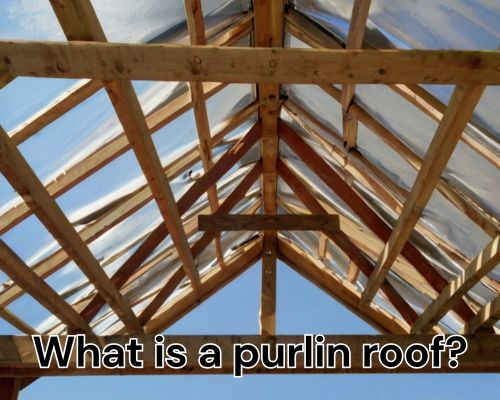If you’ve recently been chatting with roofing contractors in West Palm Beach, Florida, or you’re in the middle of a home renovation project, chances are you’ve come across the term “purlin roof.” But what exactly is a purlin roof, and why should homeowners in sunny South Florida care?

With David Spade of Star Roofing, let’s break it down—tile by tile, beam by beam.
🏗️ Understanding the Basics: What Is a Purlin Roof?
A purlin roof is a structural roofing system where horizontal beams—called purlins—support the loads from the roof deck or sheathing. These purlins rest on the principal rafters or wall posts, rather than directly on the ceiling joists. This architectural design allows for more flexibility in roof shape and spans, which is crucial for accommodating Florida’s weather conditions, including high winds and heavy rain.
Key Components of a Purlin Roof:
- Purlins: Horizontal members that support the roof deck
- Rafters: Diagonal or sloped beams that support the roof structure
- Trusses: Engineered frameworks often used in modern builds
- Roof Decking: The outer surface layer attached to purlins and rafters
The result? A strong, versatile, and energy-efficient roof structure that performs well in tropical climates like West Palm Beach.
☀️ Why Purlin Roofs Make Sense in West Palm Beach, FL
In Palm Beach County, homes must be built to withstand the brunt of Atlantic hurricanes and seasonal thunderstorms. That’s where the purlin roof system excels.
✅ Wind Resistance
Purlins allow for better anchoring of roofing materials—whether it’s metal roofing, clay tiles, or asphalt shingles—which is vital in high-wind zones like South Florida. In fact, Florida Building Code (FBC) compliance often depends on enhanced structural support, something purlin systems provide in spades.
✅ Energy Efficiency
With West Palm Beach’s blazing summers, energy efficiency is more than a buzzword—it’s a survival tactic. Purlin systems support ventilated roof designs, including ridge vents and soffit vents, which improve airflow and reduce heat transfer into your home.
✅ Design Flexibility
Whether you’re building a Spanish-style villa in Flamingo Park or a modern waterfront home near Palm Beach Shores, a purlin roofing system offers the versatility needed for architectural customization.
🏠 Types of Purlins Used in Residential Roofing
Not all purlins are created equal. Depending on the size, span, and load requirements, different types are used across West Palm Beach roofing projects.
1. C-Purlins (Channel Purlins)
Shaped like a “C,” these purlins are lightweight and perfect for residential builds where aesthetic and function meet.
2. Z-Purlins
These are stronger and used in larger span applications. The “Z” shape allows them to overlap and create continuous structural support—especially useful for metal roofs.
3. Steel Purlins
Galvanized steel purlins are common in commercial properties along Okeechobee Boulevard and increasingly found in modern eco-conscious homes.
4. Timber Purlins
Still popular in classic coastal homes and historical renovations, especially in areas like Old Northwood Historic District, timber offers a warm, rustic touch.
🔎 SEO-Friendly Insights: Why People Search “What Is a Purlin Roof?”
Let’s tap into some latent semantic indexing (LSI) keywords that people often search when learning about roofing:
- “roof framing systems”
- “metal roof support structure”
- “difference between rafters and purlins”
- “purlins vs battens”
- “roof truss types in Florida”
- “hurricane-proof roofing systems”
These searches point to a broader interest in structural durability, long-term cost savings, and materials best suited for Florida homes. This is why purlin roofs are a top contender for savvy homeowners looking for strength and style.
🧰 Installation Tips for Purlin Roofs in West Palm Beach
Before you start hammering away, make sure you’re working with a licensed roofer familiar with Florida building codes. Companies like Star Roofing or Coastal Shield Roofing Contractors (both based in West Palm Beach) specialize in custom purlin installations.
Things to consider:
- Material compatibility: Will you use wood, steel, or aluminum purlins?
- Span and load: How wide is the space, and how much weight will the roof bear?
- Ventilation: Can you incorporate ridge vents or solar attic fans?
- Local zoning codes: Purlin spacing, wind uplift resistance, and anchoring methods vary.
📉 Cost Considerations
On average, a purlin-supported roof in West Palm Beach may cost more upfront—particularly if you’re using galvanized steel or need custom trusses. However, the longevity and durability often translate into lower maintenance and better insurance premiums.
Local Roofing Cost Ranges (Estimates):
- Timber Purlin Roof: $6 – $10/sq ft
- Steel Purlin Roof: $9 – $15/sq ft
- Full Roof System (with installation): $15,000 – $30,000+ depending on size
Pro Tip: Ask for an energy audit when re-roofing. Many West Palm Beach homes qualify for energy efficiency rebates and hurricane mitigation credits.
🌴 Local Spotlight: Notable Uses of Purlin Roofs in West Palm Beach
You don’t have to look far to find impressive examples of purlin roofing systems:
- 🏛️ Norton Museum of Art – Uses architectural trusses and metal purlins in its modern wing.
- 🏫 Palm Beach Atlantic University Buildings – Known for their hurricane-resilient design elements.
- 🏠 Residential homes in neighborhoods like SoSo (South of Southern Blvd) increasingly incorporate purlin framing for aesthetic and structural benefits.
🧠 Final Thoughts: Why It Matters
So, what is a purlin roof? More than just a technical term, it’s a smart, structurally sound choice for anyone building or renovating a home in West Palm Beach, FL. It combines resilience, beauty, and sustainability—three words every South Florida homeowner should live by.
Whether you’re battling humidity, preparing for hurricane season, or just adding long-term value to your property, a purlin roof is a smart upgrade that fits right into the Sunshine State lifestyle.
🔧 Need Help with Roofing in West Palm Beach?
Connect with local experts and get a free consultation for your next roof renovation project. Don’t wait until the next storm rolls in—invest in a roof that’s built to last.